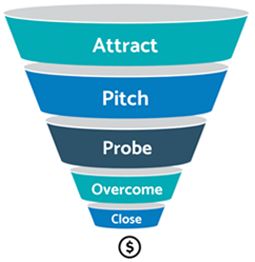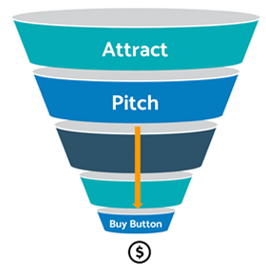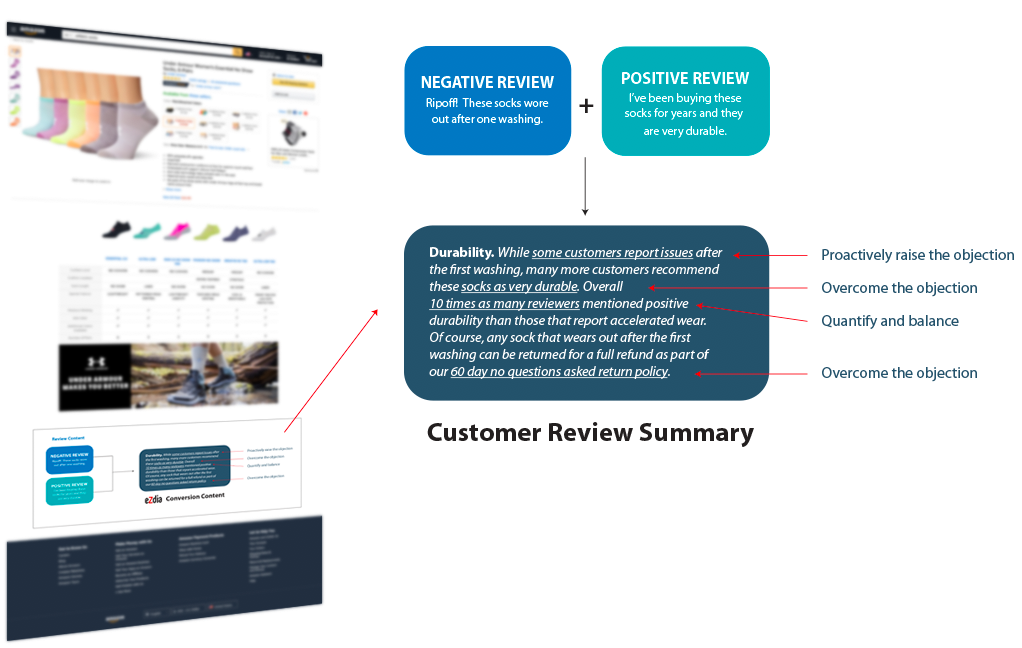Conversion Content for eCommerce
eCommerce Conversion Content is the process of identifying key customer objections and proactively addressing these objections on the product detail page in order to turn a higher percentage of visitors to the page into customers.
Higher eCommerce conversion rates will help optimize the return on ad spend (ROAS) for Search Engine Marketing (SEM) campaigns. It’s also great for driving organic traffic to the website and making all traffic to the product page more profitable.
When a well performing website registers just two transactions for every hundred visitors, there is an enormous opportunity to win one more order by using eCommerce Conversion Content.
Ask any sales rep how they sell, and they’ll tell you that they start with features and benefits just like every eCommerce product presentation, but then they probe the customer for potential objections. If they uncover objections, then they will work to overcome those objections before closing. Most eCommerce websites present the product and hope there are no objections, but eCommerce Conversion Content deploys direct marketing techniques to raise and overcome objections to drive higher sales.

Representative
Model

Traditional
eCommerce
Model

eZdia
Conversion
Content
“A Traditional Sales Rep model involves probing for objections, but eCommerce websites typically skip this step and risk a lower buy rate. eCommerce Conversion content proactively raises key objections and then overcomes those objections in an effort to turn more visitors into customers.”
How it Works
Proactively Raise Objections
Manufacturer supplied content would never proactively identify a possible customer objection. Instead, eZdia leverages product reviews to identify common product objections from across the web.
Objection
Context
eZdia ingests product reviews from across the web and tags them in order to identify the most common product objections. Then the reviews are quantified, organized by topic, and presented in a balanced fashion with the positive comments about the same objection topic.
Overcome &
Close
eZdia uses positive reviews and other compelling data to overcome the objections. eCommerce Conversion content is written using a journalistic style guide with an emphasis on leveraging the credibility.
eCommerce Conversion Content typically sits after the features and benefits and before any specifications or product reviews.

Deliverables
Conversion Content
Delivers one to three new paragraphs of original eCommerce content where each paragraph addresses a single objection.
Objection Identification
eZdia tags reviews by topic and provides a quantitative analysis of the leading customer concerns.
Per-Paragraph Pricing
eZdia’s automation tools and offshore research teams, combined with in-country copywriting, allow for inexpensive per paragraph pricing.
Test Design
eZdia will design an A/B split test to isolate the benefit of eCommerce Conversion Content against a control group.
Proof-of-Concept
eZdia offers an inexpensive 60-day proof-of-concept campaign designed to measure the return on content spend (ROCS) before scaling the strategy.
eCommerce Content Optimization
Want to learn more about how our eCommerce content services can help you to outrank your competitors?
eCommerce Conversion Content Strategies
eCommerce websites live and die by the ability to convert. It’s not enough to simply drive new visitors to a site and create lots of great viral content. Optimizing an eCommerce website requires turning that website traffic into purchases.
Converting a visit into an order requires winning on a number of fronts. It has to be the right product, the right terms, the right price, and the right availability. eCommerce Conversion content is the art of closing the deal and pushing the prospective customer to make that purchase.
Before we discuss eCommerce Conversion Content, let’s define a few types of content that are important for driving conversions but not specifically referred to as eCommerce conversion content.
Feature & Benefits Content
Most websites are pretty good at building out the features and benefits of a product. There is usually a paragraph or two on a product detail page (PDP) that describes the product followed by a series of bulleted content designed to make it easy to absorb both what you get when you buy plus how you can expect to benefit. Feature and benefit content is a necessary component of converting a customer but its goal is to inform more than convert.
Romantic Content
Romantic content is sometimes thought of as that flowery language that is designed to connect with the prospective customer and create a vision for what life would be like if you are smart enough to buy that content.
Buyer’s Guides
This is the most popular form of long-form content on an eCommerce site. This is an opportunity to teach a prospective customer how to make an intelligent purchase decision. Buyer’s guides attempt to frame the decision criteria and coach the customer into the right mindset to make a purchase with confidence. Buyer’s guides are great at reducing perceived risk and convincing the buyer that they have enough expertise to make an intelligent purchase decision.
Conversion Content & The Sales Funnel
Before discussing Conversion Content let’s take a step back and talk about sales outside of the eCommerce universe. Before there were eCommerce sites there were sales professionals that for hundreds of years have been talking people into exchanging their hard-earned money for whatever they have to sell.
Successful sales strategies are well understood. They involve understanding the customer’s needs and aligning that with your company’s solution. A good sales guy probably makes every effort to make sure that you understand every ounce of the value you are about to receive. This is the “feature and benefit” content that eCommerce does the same.
The best sales professionals go well beyond just presenting the product and hoping they will buy. Sales knows that you need to understand the customer’s purchase decision process well enough to help guide that decision through to a conversion. That’s where traditional Selling and eCommerce start to diverge. Good sellers will work to uncover things like any objections that the customer may have and then work to overcome those objections. Identifying and overcoming objections is the key to closing more sales, but its missing from eCommerce.
Conversion Content Defined
eCommerce Conversion content is the use of persuasive writing techniques that proactively volunteer possible objections and overcome them on the product page.
eZdia’s approach to eCommerce Conversion Content does this by leveraging the breadth of product reviews across the internet. These reviews are the eCommerce equivalent to clues both about customer value perception (positive reviews) and objections (negative reviews). Instead of putting the burden on the customer to read the reviews, this acts as a key summary of reviews. And since it doesn’t quote or reference specific customers, there is no issue in using product reviews where we find them.
The end result is journalistic in tone and style designed to honestly represented as a summary of the reviews. The most popular negative themes then get converted into a pre-sale concern. The concern is described and quantified to put the review in the context of all the reviews. Then we use positive reviews to attempt to overcome the concern. This has the impact of making review content easier to digest and at the same time leverages the most credible content on the site. Frankly even modest improvements in conversion rate can have a significant overall impact on the business.
Proof of Concept
Try this for yourself. It’s easy enough to do. Take a handful of products and read every review on your website and other websites. Summarize, quantify and categorize each review. Identify the top likely objections by focusing on the negatively related themes from the reviews.
Now just report the facts that some customers were concerned about a given topic. Put that topic in context by quantifying the proportion of people that shared this concern and then detail the most common themes from positive reviews that might counter the negative review. Throw in a few site benefits (like return policy) into the discussion and try to let the facts present a conclusion that signals a buy. If the data isn’t there to support that “buy” then pick different products.
Now start driving traffic to the page. Fund a paid product listing program but identify a control group of products you can compare to and measure the incremental change in conversion rate in order to estimate the value of the strategy. One more customer here and there may not feel like a big deal but when it’s scaled across the full product line these extra sales start to add up. Paid search is used to accelerate a test. In all likelihood improvements here will be seen across all acquisition channels.
Good strong eCommerce content strategies should guide any company’s effort to attract, engage and convert website visitors. Thinking about content and how different content techniques can accomplish different objectives for eCommerce sites.
Frequently Asked Questions
What is eCommerce conversion content?
eCommerce conversion content is the use of persuasive writing techniques designed to overcome visible customer objections. Customer reviews is an excellent source of objection content. Conversion content is defined as the content that is targeted at specific common customer objections and the words required to overcome that objection. Most page visitors fail to convert from visitor into customer and this is pre-planned content designed to identify people close to saying yes and addressing their most likely objections. Ideally this is accomplished by using positive customer reviews in order to get the maximum credibility possible. This type of content won’t quote specific customers, but is designed to elevate the most important reviews. And as the name suggests, such content will help boost conversion rate for e-commerce sites by addressing key concerns of customers through quick information.
What are the key features of eCommerce conversion content?
eCommerce conversion content works the way sales people have always sold. eCommerce conversion content helps online stores close the deal by removing obstacles to the prospective customer making the purchase. The key features of eCommerce conversion Content center on identifying common product objections and then using review content to overcome those objections. Another key feature is that it summarizes the customer input on the most common topics and makes it easier to access than reading individual reviews. There is no more credible way to overcome objections than to use targeted customer reviews and the result is a higher conversion rate across all acquisition channels.
Why is conversion content important for eCommerce websites?
The best eCommerce sites fail to convert visitors 95% of the time. Imagine if this was a physical retail store and 95% of the store’s visitors walked out of the story without a purchase. There is no single strategy to improve the percentage that ultimately purchase, instead sites need to identify the most common blockers to a sale and attempt to address those issues with well targeted and highly credible content. And even a small improvement in the conversion rate can have a big impact on profitability of acquisition channels if a higher percentage of visitors complete a transaction.
What’s the role of keywords in eCommerce conversion content?
Keywords have a huge role to play in eCommerce conversion content as their strategic use can help online stores attract, engage and convert more visitors. Sites can use keywords to summarize, quantify and categorize reviews and then recognize the themes of objections and try to replace them with positive themes. eCommerce sites can choose the right keywords to convince unhappy customers and then attempt to give them credible reasons to buy the product. By using the right keyword or phrase term, it is easy to support the theme that online stores want to put in front of their customers and win their trust.